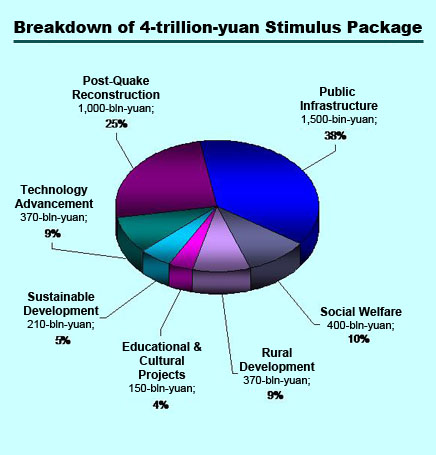China's Stimulus Package: A Breakdown of Spending
The Chinese government has reviewed its investment priorities under the 4-trillion-yuan stimulus package introduced in autumn last year, with more emphasis given to social welfare projects, rural development, and technology advancement.
China's top economic planner, the National Development and Reform Commission (NDRC), unveiled a breakdown (*see chart below) of the revised stimulus package spending during a news conference on March 6.
NDRC chief Zhang Ping told the media that the total amount of the stimulus package remained unchanged, but allocations for certain projects had been cut to re-channel the funds to expedite rural public works and social welfare projects.
Technology advancement to facilitate the structural reform of industries would also receive increased funding, he added.
The stimulus package - to be spread over a period of two years - was introduced late last year following the fallout of the US financial crisis. It aimed to boost the slowing Chinese economy by spurring domestic spending and demand, as its GDP growth slid to 9% in 2008 after years of double-digit growth.
Although more signs of slowing down - such as falling exports and climbing unemployment - emerged months after the stimulus package was first unveiled, there was no indication that the Chinese government would enlarge the stimulus pool, and the top leadership reiterated at the NPC opening that this year's GDP growth target remained as 8%.
Zhang said the make-up of the stimulus spending would undergo adjustments as the economic climate changed, adding the latest revised spending fell under seven broad areas.
Public infrastructure development took up the biggest portion -- 1.5-trillion yuan, or nearly 38% of the total package. The projects lined up include railway, road, irrigation, and airport construction.
The second largest allocation - one trillion yuan - went to reconstruction works in regions hit by the 8-magnitude Sichuan earthquake last May; that was followed by funding for social welfare plans, including the construction of low-cost housing, rehabilitation of slumps, and other social safety net projects.
Rural development and technology advancement programs shared the same amount of allocation - at 370 billion yuan each. Rural projects in the pipeline included building public amenities, resettling nomads, supporting agriculture works, and providing safe drinking water.
Technology advancement mainly targeted at upgrading the Chinese industrial sector, gearing towards high-end production to move away from the current export-oriented and labor-intensive mode of growth. This was in line with the government's latest Blueprint for revitalizing 10 selected industries.
To ensure sustainable development, the Chinese government also allocated some 210 billion yuan, or 5.3% of the stimulus package for promoting energy saving and poison gas emission cuts, and environmental engineering projects.
Last but not least, 150 billion yuan was allocated for educational, cultural and family planning purposes.
Zhang reiterated that the stimulus investments required cost-sharing between the central government, local governments and private sectors. The foremost would fork out 1.18 trillion yuan.
The cost-sharing formula varied, but Zhang gave an example on educational spending, which he said two-thirds of the funding would come from the central while the remaining from local governments.
The above news conference was held in conjunction with the on-going annual plenary sessions of China's parliament (NPC) and the country's top political advisory body, commonly known as the Two sessions (Liang Hui). The sessions would conclude on March 13.
The views posted here belong to the commentor, and are not representative of the Economic Observer |




















